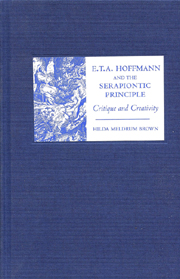Book contents
- Frontmatter
- Contents
- List of Illustrations
- Preface
- Acknowledgments
- List of Abbreviations
- Introduction: Approaches to the Serapiontic Principle
- Part 1
- Part 2
- 7 Frame Narrative and the Serapiontic Principle
- 8 From Visual to Verbal: Three Serapiontic Tales
- 9 The “Nachtseite der Natur” and the Serapiontic Principle
- 10 The Märchen and the Serapiontic Principle
- 11 The Serapiontic Principle: The Wider Critique
- Conclusion
- Select Bibliography
- Index
8 - From Visual to Verbal: Three Serapiontic Tales
from Part 2
Published online by Cambridge University Press: 05 February 2013
- Frontmatter
- Contents
- List of Illustrations
- Preface
- Acknowledgments
- List of Abbreviations
- Introduction: Approaches to the Serapiontic Principle
- Part 1
- Part 2
- 7 Frame Narrative and the Serapiontic Principle
- 8 From Visual to Verbal: Three Serapiontic Tales
- 9 The “Nachtseite der Natur” and the Serapiontic Principle
- 10 The Märchen and the Serapiontic Principle
- 11 The Serapiontic Principle: The Wider Critique
- Conclusion
- Select Bibliography
- Index
Summary
Introduction
Artistic inspiration for Hoffmann derives from many sources. The origins of a process that he sometimes metaphorically terms “kindling” (“entzünden”), and the spark that ignites the imaginative faculties, may be traced to random associations formed between things seen and things interpreted, visual perceptions and mental transformations. As we have observed, the supremacy of visual perception in Hoffmann's time is rapidly being challenged by other faculties that are less easy to identify precisely — hence Hoffmann's portmanteau term “inneres Schauen” to describe the one to which he attaches special importance, a term that makes it clear that his aesthetic aim has to be distinguished from mimesis. One of the most interesting features of this approach is the fact that everything observed — the entire world, whether in the raw state or “gedeutet” — is a candidate for further transformation, and that this principle applies as much to artworks created by others, which themselves may have been the finished product of similar transformations, as it does to straightforward, unprocessed material. In order to make his position abundantly clear, Hoffmann himself will regularly point the reader in the direction of his source material, whether this be an anecdote by G. H. Schubert (as in the case of Die Bergwerke zu Falun) or, as in the case of the three tales from the Serapionsbrüder that are based on contemporary paintings, by giving details in two of the three cases about the date and place of the exhibitions in Berlin at which the works were displayed, the names of the artists, and their titles.
- Type
- Chapter
- Information
- E. T. A. Hoffmann and the Serapiontic PrincipleCritique and Creativity, pp. 135 - 156Publisher: Boydell & BrewerPrint publication year: 2006



